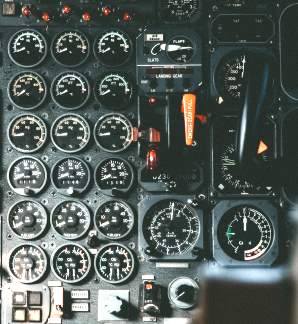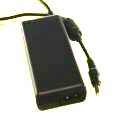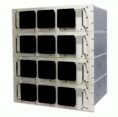
August 1, 2024
400 Hz tutorial: generation and conversion of 400Hz power
IntroductionVarious frequencies have been used for AC transmission, 60Hz and 50Hz are the most common. Low frequencies are used because radiation losses are lower at lower frequencies. Radiation losses are basically radio waves emitted from the wires at that frequency, which wastes power that should have been going down the wires. Radiation losses for 400Hz are 40 times as high as 60Hz, and 60 times as high as 50Hz. However, transformers for 60Hz are bigger and heavier. So for the short distances involved in aircraft, and the advantage of smaller and lighter transformers, motors and filter capacitors, 400Hz was adopted, particularly for military aircraft: MIL-STD-704F states: “Equipment designed for use on military aircraft should not use 60 Hz power, since it requires more weight and prime mover capacity per unit of power consumed by the utilization equipment." Specifications for normal operation of 400Hz equipment.
Boeing 787 and Airbus A380These modern aircraft have opted to do without the alternator speed regulator required to keep the frequency stable. Therefore their frequencies extend from about 360 Hz to 800 Hz depending on the speed of the engines. RectificationTo prevent problems in the aircraft power system half wave rectification is forbidden. Thus for low voltage power supplies full wave rectifiers or switchmode power supplies are preferred. Three phase requirements
When higher powers are required three phase is mandated. In military aircraft powers greater than 500VA or 500 Watts require 3-phase power. Skin depth at 400HzAlternating current likes to distribute the current in a wire in such a way that the maximum current is at the outside of the wire, a consequence of Gauss's law. For high frequencies and large wires the current can be mostly on the “skin” of the wire. The skin depth is the distance from the surface where the current density is 1/e of the maximum at the surface. 60Hz has a skin depth in copper of 8.4 mm, so even with a 0000 AWG wire (11mm diameter) the skin effect can be neglected. At 400Hz the skin depth is 3.3 mm, so wires thicker than 8 gauge will have more resistance than expected. Litz wire, which is individual strands of thin insulated wire woven into a cable can be used to avoid the skin effect. 3-Phase power calculations at 400HzTo calculate power in single phase power you just multipy the amps times the volts. In three phase it is amps times volts times the square root of 3 (about 1.732). Power conversion equipmentPower conversion equipment can take the 400Hz input and create 60Hz AC (frequency conversion), DC (transformer-rectifier). We can also transform single phase to three phase, and 400Hz to 60Hz, and invert DC to 400Hz and 400Hz to DC. 1. Start with 60Hz and transform to 400Hz. Mechanical motor-generator rotary converters used to be widely used. Now, with modern power semiconductors, these frequency converters consist of a rectifier to create DC and an inverter to make the 400Hz all in one unit.100 Watt 60Hz to 400Hz power supply and ground power unit 250 Watt 60Hz to 400Hz power supply and ground power unit  500 VA 60Hz to 400Hz power supply and ground power unit  1000VA 60Hz to 400Hz power supply ground power unit  1a. Start with 60Hz single phase and transform to 400Hz 3-phase.600VA 60Hz single phase to 400Hz three-phase ground power
2. Start with 400Hz and transform to 60Hz. To use 60Hz equipment in aircraft a similar converter rectifies the 400Hz and then converts the DC to 60Hz using an inverter. 500 Watt 400Hz to 60Hz converter 1250 Watt 400Hz to 60Hz converter 
3. Start with 400Hz and transform to DC voltage. A number of switchmode power are available to make any DC voltage, or even charge batteries when plugged into 400Hz.DC power supplies from 3V to 48V with 400Hz AC input
4. Start with DC and create 115VAC 400Hz. These are just inverters with 400 Hz output.12V, 24V or 48VDC to 115VAC 400Hz 1800Watts  DC to 400Hz AC inverters 40VA to 1000VA 
5. Start with DC and create 400Hz 3-phase12V, 24V or 48VDC input to 115VAC 400Hz 3-phase at 1800 Watts 24VDC, 48VDC, 125VDC or 250VDC to 3-phase 3kVA or 6kVA 400Hz 
6.Start with 60Hz single phase to create 400Hz 3-Phase115VAC or 230VAC 60Hz single phase input, to 3kVA three-phase 400Hz 7.Start with 3-phase 60Hz to create 3-phase 400Hz.Three phase 50Hz or 60Hz to three phase 400Hz 1.5kVA to 6kVA
8. Start with single phase 400Hz to create single phase 60Hz.Single phase 3000 Watt 115VAC 400Hz to 115VAC 60Hz AC/AC frequency converter.
9. Transformers.Can I use a transformer designed for 60 Hz at 400 Hz? Yes, a transformer that is designed for 60Hz operation will work at 400Hz, but may have a loss in efficiency due to eddy currents and skin-effect increase in resistance.Can I use a transformer designed for 400Hz at 60Hz? Again, yes, but the voltage must be derated by the ratio (60/400). This is to prevent the core from saturating. I have beautiful little 3-phase Variac designed for 400Hz. It is so cute and unique that I can't bear to surplus it, so I am waiting for an application where we have to test three phase 60 Hz at 17 volts. |
|
|
|
| |||||||||